Hello there,
I´m back with a few general Questions considering T-Line design and some other stuff as well.
I play around with Hornresp, and came up with to designs I wanted to try.
I build tow Test speakers, and experimented with different cross sections and “Tapers”.
One Speaker is tuned to 95Hz
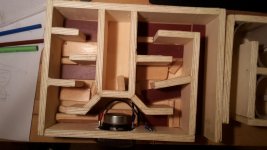
: it is the winner in a direct sound comparison between those tow, got better dynamic range and the sound apers to be more open, all thou a tiny bit more “blurry” but all the details are there. The other one has a less dynamic and the sound is more concentrated in a small spot, but the detail´s seem to be more pronounced this one is tuned to 109Hz
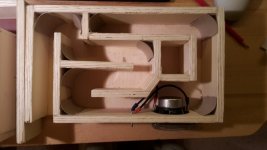 .
.
A Few things must be said first:
-the sound only was quantifyed by hearing
-the speakers do have different tuning and maze-layouts
-the enclosures where designed to be operated with filling, but I didden´t do that... big dump
These tow speakers led to a few Question and ideas which I hope to be somewhat constructive.
First of all doas the maze layout affect the sound, sure it doas:
But could it be in some way desirable to have a symmetrical-ich layout of the maze next to the speaker. (since the better sounding one of my speakers cinda is symmetrical while the other is not, could this be one of the )many( reasons). This assumption seems intuitif right but is it thou?
=>Should I design my next test subject in a symmetrical way or is that irrelevant?
How doas sound travel through corners: (illustrated with drawing for better understanding)
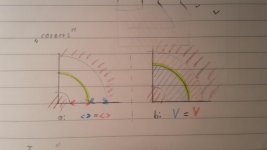
a: doas it travel the way with half the radii?
b: doas it teak the way with the radii where both left and right volumes are the same?
c: neither of those
What effective distance sound travels in “corners” and how is it calculated?
(The final speaker´s are required to be very space effective. Having the sound travel a grater distance in “corners” than I´v assumed would play in my favoured)
i`ve been going with a: but now b: sound´s moor plausible to me
Tapering the Port: (sketch fore better understanding)
making “corners” tapered is quit hard to accomplish but having a linear taper along the way is also difficult fore me to accomplish. So here I wanted to check if the way I plan to integrate tapers in my design is applicable.
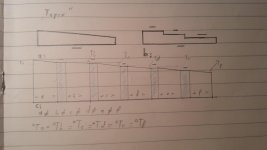
a: ideal Taper
b: this is how I tested Tapers in my speakers
c: this is how i´m going to design the tapers into the speakers
My design:
-As mentioned no “corners” are tapered (blue in sketch)
-I divide the port in 6 sections where each section is a different length
-The volume each taper teaks away from the maze is identical
i`m going with it any way except it is a super bad thing to do, but I imagen this being good enough.
How about putting waves into the waveguides edges: (with sketch)
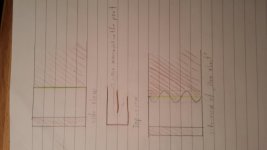
This approach is normally used to lover the pressure level´s of a port do to the increased surface area. I´m wondering if such design could help reduce resonance or benefit sound in any other way. I could Imagen that such a waveguide design increases the bandwidth the port covers do to the on some parts increased/lovered distance the sound has to travel?
Or dosen´t it affect sound at all?
Would be nice if you could share your thoughts or experience on this.
If anything is known abut the effects of such waveguide edges is known pleas let me kno.
Thanks for making it this fare, You are encouraged to share your thoughts on every thing I mentioned above.
Thanks fore reading, have an awesome day.
I´m back with a few general Questions considering T-Line design and some other stuff as well.
I play around with Hornresp, and came up with to designs I wanted to try.
I build tow Test speakers, and experimented with different cross sections and “Tapers”.
One Speaker is tuned to 95Hz

: it is the winner in a direct sound comparison between those tow, got better dynamic range and the sound apers to be more open, all thou a tiny bit more “blurry” but all the details are there. The other one has a less dynamic and the sound is more concentrated in a small spot, but the detail´s seem to be more pronounced this one is tuned to 109Hz
 .
.A Few things must be said first:
-the sound only was quantifyed by hearing
-the speakers do have different tuning and maze-layouts
-the enclosures where designed to be operated with filling, but I didden´t do that... big dump
These tow speakers led to a few Question and ideas which I hope to be somewhat constructive.
First of all doas the maze layout affect the sound, sure it doas:
But could it be in some way desirable to have a symmetrical-ich layout of the maze next to the speaker. (since the better sounding one of my speakers cinda is symmetrical while the other is not, could this be one of the )many( reasons). This assumption seems intuitif right but is it thou?
=>Should I design my next test subject in a symmetrical way or is that irrelevant?
How doas sound travel through corners: (illustrated with drawing for better understanding)

a: doas it travel the way with half the radii?
b: doas it teak the way with the radii where both left and right volumes are the same?
c: neither of those
What effective distance sound travels in “corners” and how is it calculated?
(The final speaker´s are required to be very space effective. Having the sound travel a grater distance in “corners” than I´v assumed would play in my favoured)
i`ve been going with a: but now b: sound´s moor plausible to me
Tapering the Port: (sketch fore better understanding)
making “corners” tapered is quit hard to accomplish but having a linear taper along the way is also difficult fore me to accomplish. So here I wanted to check if the way I plan to integrate tapers in my design is applicable.

a: ideal Taper
b: this is how I tested Tapers in my speakers
c: this is how i´m going to design the tapers into the speakers
My design:
-As mentioned no “corners” are tapered (blue in sketch)
-I divide the port in 6 sections where each section is a different length
-The volume each taper teaks away from the maze is identical
i`m going with it any way except it is a super bad thing to do, but I imagen this being good enough.
How about putting waves into the waveguides edges: (with sketch)

This approach is normally used to lover the pressure level´s of a port do to the increased surface area. I´m wondering if such design could help reduce resonance or benefit sound in any other way. I could Imagen that such a waveguide design increases the bandwidth the port covers do to the on some parts increased/lovered distance the sound has to travel?
Or dosen´t it affect sound at all?
Would be nice if you could share your thoughts or experience on this.
If anything is known abut the effects of such waveguide edges is known pleas let me kno.
Thanks for making it this fare, You are encouraged to share your thoughts on every thing I mentioned above.
Thanks fore reading, have an awesome day.
Last edited by a moderator:
First of all doas the maze layout affect the sound
I can say that the type of folding in the 2nd is typically more space sufficient,
But the first with more bends, will have more LP filters caused by the line area increase/decrease at the bends.
How are these damped? Given the tuning they are more useful as midTLs anc should be damped until aperiodic.
dave
The final speaker will have parallel bends which will result in no LP filter effect, which is a good thing. right?
Which maze is more space effective depends on which distance the sound effectively travels in a bend i went with “half radii” => it travels less distance then it could when travelling strait. But when you go by the radii at which both volumes are the same the sound traffles slightly further => so this would be more efficient. But I don’t now what distance the sound travels effectively hopefully someone doas
Jah, these speaker`s are not damped but suld be, just build them and later on noticed that there is dampening to be added which I did not do.
Which maze is more space effective depends on which distance the sound effectively travels in a bend i went with “half radii” => it travels less distance then it could when travelling strait. But when you go by the radii at which both volumes are the same the sound traffles slightly further => so this would be more efficient. But I don’t now what distance the sound travels effectively hopefully someone doas
Jah, these speaker`s are not damped but suld be, just build them and later on noticed that there is dampening to be added which I did not do.
The LP filter effect is beneficial. Everytime you lose 1 a little more HF stuff that you do not want, reaches the terminus, so someother method (like more damping) is needed to kill those HF.
The bends are quite useful in a BLH, with the damping in a TL one can manipulate the LP filters to get the result you are aiming towards.
You cannot realistically evaluate an undamed TL.
Damp them and listen again.
dave
The bends are quite useful in a BLH, with the damping in a TL one can manipulate the LP filters to get the result you are aiming towards.
You cannot realistically evaluate an undamed TL.
Damp them and listen again.
dave
What effective distance sound travels in “corners” and how is it calculated?
Greets!
Sorry, don't have time ATM to pick through all this, but corner design was heavily researched some years ago:
The Subwoofer DIY Page - Horn Folding
Spreadsheet for Folded Horn Layouts...
The LP filter effect is beneficial. Everytime you lose 1 a little more HF stuff that you do not want, reaches the terminus, so someother method (like more damping) is needed to kill those HF.
The bends are quite useful in a BLH, with the damping in a TL one can manipulate the LP filters to get the result you are aiming towards.
Dave,
If understood right by "bends" you meant the internal "turns" in labyrinth.
IF so every advantage costs the price. Do you know any impacts when you more bends\turns?
I saw one article with statement that less turns offers better sound in terms of less group delay of TL port line. So the less group delay "the faster" bass.
I appreciate if any wrong statements above would be strictly argued against.
Yes bends are the changes in the direction the line goes, folds.
One has to take more care if one wants an accuarte sim of a folded TL, but it rarely makes much difference in a TL, in a BLH more so.
The sound can be different. If you do not have folds you have to compensate with some other method to add more LP function (driver offset, mass-loading for example.
Again, in a TL, only small differences (the volume of the folded line will be larger typically), so something i do not often worry about.
In a horn, if you have more HF coming out the mouth you will have more group delay (i think), so a folded horn should have less group delay.
dave
One has to take more care if one wants an accuarte sim of a folded TL, but it rarely makes much difference in a TL, in a BLH more so.
The sound can be different. If you do not have folds you have to compensate with some other method to add more LP function (driver offset, mass-loading for example.
Again, in a TL, only small differences (the volume of the folded line will be larger typically), so something i do not often worry about.
In a horn, if you have more HF coming out the mouth you will have more group delay (i think), so a folded horn should have less group delay.
dave
Dave, yes, the more we make damping the less HF output from the port.
When I crafted my first (and last) TL I had to put internally pieces of synth fiber mass, but not tightly compressed but against some "airy" exploded. Initially TL was modeled by hornresp and after build without internal filling I had big peak at port resonance frequency. To make it more compliant to the model I had put empirically in several places pieces of fiber and exact places and amount were chosen only by mic measurement where resonance became more flat\low Q . Also walls of TL covered with 10mm of synth batting.
So that time I asked myself: Did I made mistake to choose TL with small number of turns instead of 6th turns well known design
So when you stated about number of bends\turns it reminds about possible "looses" in final result. But anyway I'm happy with TL now
When I crafted my first (and last) TL I had to put internally pieces of synth fiber mass, but not tightly compressed but against some "airy" exploded. Initially TL was modeled by hornresp and after build without internal filling I had big peak at port resonance frequency. To make it more compliant to the model I had put empirically in several places pieces of fiber and exact places and amount were chosen only by mic measurement where resonance became more flat\low Q . Also walls of TL covered with 10mm of synth batting.
So that time I asked myself: Did I made mistake to choose TL with small number of turns instead of 6th turns well known design
So when you stated about number of bends\turns it reminds about possible "looses" in final result. But anyway I'm happy with TL now
- Home
- Loudspeakers
- Full Range
- Questions ideas regarding waveguids // port design t-line
